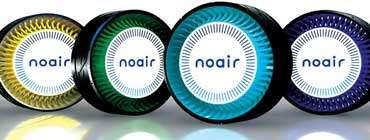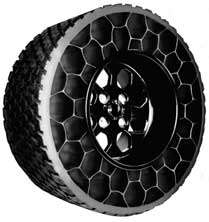In response to a rising trend for safe and environmentally friendly transportation, more tyre makers are jumping on board the airless tyre bandwagon with new prototypes set to enter commercial production in the coming years, according to Angelica Buan in this report.
Airless tyres for lower maintenance
Since road traffic accidents are one of the leading causes of fatalities worldwide, vehicle safety is essential for avoiding collisions and lowering the risk of serious injury, and tyres are an important component of vehicle safety. Preventing blowouts or sudden loss of air pressure require checking for inflation and wear and tear on a regular basis; and avoiding potholes or other road debris, as well as overloading.
Tyre maintenance, on the other hand, is both inconvenient and costly. Drivers expect both safety and convenience when travelling from point A to point B, and tyres must meet these expectations.
It is not surprising that non-pneumatic tyres (NPTs) or airless tyres have piqued consumer interest due to the fact that they are low-maintenance and environmentally friendly.
How is this even possible? Because it is not supported by air pressure, an airless tyre is puncture-proof. It also has less suspension and higher rolling friction than pneumatic tires of similar shape and size. When driven, however, airless tyres can disperse the heat that builds up.
New developments, on the other hand, are being made to improve the properties of airless tyres in order to eliminate performance issues and expand their application to a wider range of vehicle types.
No to flat tyres, yes to low carbon emissions
The global airless tyre market is expanding as demand for maintenance-free tyres grows and the adoption of all-terrain and military vehicles, such as armoured trucks, backhoes, and cranes, increases. Airless tyres may also become a standard feature for concept cars and electric vehicles in the coming years.
Several tyre manufacturers, in fact, are already developing and testing prototypes of next-generation airless tyres that ensure safe, blow-out-proof transportation while emitting low carbon emissions.
Japanese tyre maker Toyo Tires has been researching airless tyres since 2006 and in 2012, showed a prototype at a technology exhibition. From then on, the company has introduced changes to the tyre structure, creating better prototypes with improved performance and says its “no-air” concept tyre continues to evolve.
The basic tyre structure is made up of special high-rigidity resin spokes from the inner core to ensure adequate strength to support the load. The use of a rubber material for the outer tread that comes into contact with the road surface also improves basic tyre performance, namely “drive, turn, stop” functions. The section between the spokes and the rubber tread, known as the outer diameter ring, is reinforced with carbon fibre-reinforced plastic (CFRP), which helps to reduce the load on the spokes.
Previous prototypes supported the load via an elliptical spoke configuration, according to Toyo Tires, but the latest version has progressed into an x-shaped spoke configuration that alternately crosses the width of the no-air tyre from the outside to the inside and vice versa. Durability has been improved by achieving a completely unique support configuration form, it adds.
Moreover, relative to the earlier model, the number of spokes has been doubled (100 pitch), distributing contact pressure, reducing impact sounds from the spokes when they come into contact with the ground, thus achieving an even quieter ride, Toyo Tire explained, adding that it is constantly conducting research to improve its tyre and resolve certain design issues before it is put into practical use.
Similarly, Dutch materials firm DSM, has joined the airless tyre market with its Arnitel TPE polymers and compounds. Since 2005, DSM has been working with tyre manufacturers and OEMs to find the best material solution for NPTs.
In its concept, DSM says the airless tyre is typically made up of a metal central hub that connects to the axle, an elastic Arnitel “web” structure, and an outside rubber thread. Arnitel also allows NPTs to have a service life that is up to three times longer than a traditional tyre that wears out faster. Apart from the flex fatigue endurance, high load bearing capability, dynamic creep and tear resistance, Arnitel’s thermal properties allow an NPT to perform consistently in a variety of climate conditions from -30 to +100°C.
Meanwhile, Bridgestone is another key forerunner in the development of airless tyre concepts, having announced in 2011 that it had developed its version that could prove to be a viable and more environmentally friendly alternative to conventional tyres in the future.
Despite the potential benefits of such concept tyres, they have previously been impractical to mass-produce and Bridgestone stated that this technology was developed with the goal of mass producing.
In Bridgestone’s version, the spoke structure within the tyre is made of reusable thermoplastic resin, and the materials used in the tyres, along with the rubber in the tread portion, are 100% recyclable.
Its second generation NPT was launched in 2013 with an optimised spoke structure using high-strength, flexible high-performance resin as a material and employing finite element method (FEM) simulations in the design to reduce stress and deformation in the tyre’s inner part. Bridgestone adds that it has also used proprietary materials and simplified the tyre structure, thereby resulting in a significant reduction in energy loss. Its pneumatic fuel-efficient tyres have a low rolling resistance similar to its low rolling resistance.
Bridgestone, which adapted the air free concept in 2017 to develop puncture-free bicycle tyres, said that it is advancing development of the air-free concept tyre and aims to bring about commercial use in a wide range of vehicles as soon as possible.



